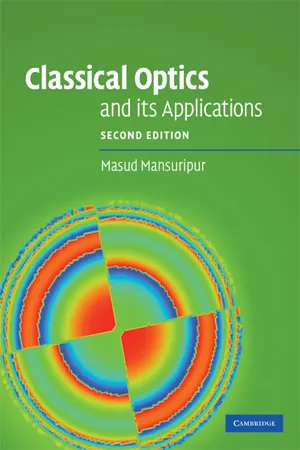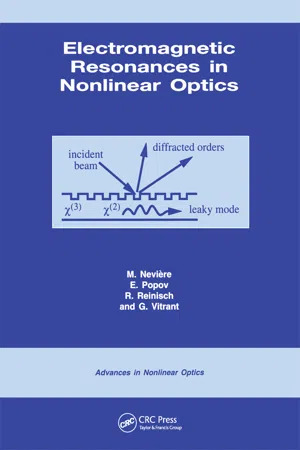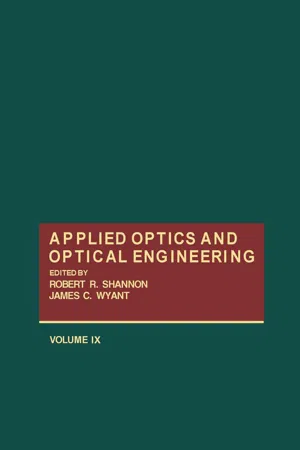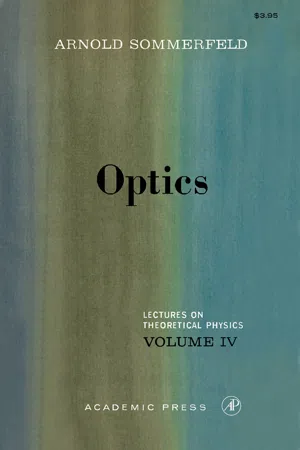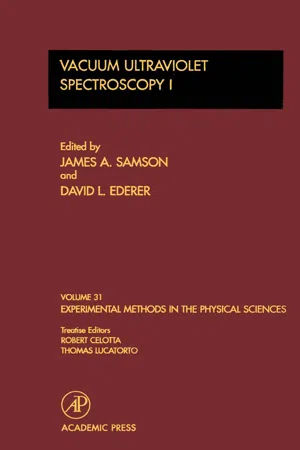Physics
Diffraction Gratings
Diffraction gratings are optical components with a series of closely spaced, parallel slits or grooves that diffract light. When light passes through a diffraction grating, it is dispersed into its component wavelengths, creating a spectrum. This dispersion property makes diffraction gratings useful in spectroscopy and other applications where precise wavelength separation is required.
Written by Perlego with AI-assistance
Related key terms
1 of 5
9 Key excerpts on "Diffraction Gratings"
- eBook - PDF
- William Moebs, Samuel J. Ling, Jeff Sanny(Authors)
- 2016(Publication Date)
- Openstax(Publisher)
Diffraction Gratings work both for transmission of light, as in Figure 4.14, and for reflection of light, as on butterfly wings and the Australian opal in Figure 4.15. Natural Diffraction Gratings also occur in the feathers of certain birds such as the hummingbird. Tiny, finger-like structures in regular patterns act as reflection gratings, producing constructive interference that gives the feathers colors not solely due to their pigmentation. This is called iridescence. Figure 4.14 (a) Light passing through a diffraction grating is diffracted in a pattern similar to a double slit, with bright regions at various angles. (b) The pattern obtained for white light incident on a grating. The central maximum is white, and the higher-order maxima disperse white light into a rainbow of colors. Chapter 4 | Diffraction 159 Figure 4.15 (a) This Australian opal and (b) butterfly wings have rows of reflectors that act like reflection gratings, reflecting different colors at different angles. (credit b: modification of work by “whologwhy”/Flickr) Applications of Diffraction Gratings Where are Diffraction Gratings used in applications? Diffraction Gratings are commonly used for spectroscopic dispersion and analysis of light. What makes them particularly useful is the fact that they form a sharper pattern than double slits do. That is, their bright fringes are narrower and brighter while their dark regions are darker. Diffraction Gratings are key components of monochromators used, for example, in optical imaging of particular wavelengths from biological or medical samples. A diffraction grating can be chosen to specifically analyze a wavelength emitted by molecules in diseased cells in a biopsy sample or to help excite strategic molecules in the sample with a selected wavelength of light. Another vital use is in optical fiber technologies where fibers are designed to provide optimum performance at specific wavelengths. - eBook - PDF
- C.R. Kitchin(Author)
- 2013(Publication Date)
- CRC Press(Publisher)
Thus, the resolutions range from 10 3 to 10 5 . Although the earlier discussion was based upon the use of clear apertures, a narrow plane mirror can replace each aperture without altering the results. Thus, Diffraction Gratings can be used either in transmission or reflection modes. Most astronomical spectroscopes are in fact based upon reflection gratings. Often the grat-ing is inclined to the incoming beam of light, but this changes the discussion only mar-ginally. There is a constant term, d sin i , added to the path differences, where i is the angle made by the incoming beam with the normal to the grating. The whole image (Figure 4.3) is shifted an angular distance i along the image plane. Equation 4.13 then becomes θ λ = - -si n s in 1 m d i (4.24) and in this form is often called the grating equation. Volume phase holographic gratings (VPHGs) are currently starting to be used within astronomical spectroscopes. These have a grating in the form of a layer of gelatine within which the refractive index changes (Section 4.2), with the lines of the grating produced by regions of differing refractive indices. VPHGs operate through Bragg diffraction Spectroscopy ◾ 345 (Section 1.3, Figure 1.102 and Equation 1.104). Their efficiencies can thus be up to 95% in the first order. They can be used either as transmission or reflection gratings and replace conventional gratings in spectroscopes at the appropriate Bragg angle for the operating wavelength. To form a part of a spectroscope, a grating must be combined with other optical ele-ments. The basic layout is shown in Figure 4.4; practical designs are discussed in Section 4.2. The grating is illuminated by parallel light that is usually obtained by placing a slit at the focus of a collimating lens, but sometimes may be obtained simply by allowing the light from a very distant object to fall directly onto the grating. - eBook - PDF
- Masud Mansuripur(Author)
- 2009(Publication Date)
- Cambridge University Press(Publisher)
8 However, it is only during the past thirty years or so that a thorough understanding of nearly all aspects of the behavior of Diffraction Gratings has been achieved through the consistent application of Maxwell’s equations with the help of advanced analytical and numerical techniques. 2,9,10 Modern gratings having a few thousand lines per millimeter with near- perfect periodicity are fabricated over fairly large areas (grating diameters of around one meter or so are possible). The groove shapes can be con- trolled to be sinusoidal, rectangular, triangular, or trapezoidal, and one can obtain shallow or deep grooves (relative to the groove width) by current manufacturing techniques. These gratings can be made on various metal, plastic, and glass substrates and, when necessary, they can be coated with thin-film metal and/or dielectric stacks. The primary applications of diffrac- tion gratings are still in spectroscopy, where they are used for analyzing the frequency content of electromagnetic radiation (visible light, ultraviolet, X-rays, infrared, microwave), but they are also used as wavelength selectors in tunable lasers, beam-sampling mirrors in high-power lasers, band-pass filters, pulse compressors, and polarization-sensitive optics, among other applications. The goal of the present chapter is to describe some of the basic properties of gratings and to point out through several examples the complex behavior of these devices. These examples are by no means comprehensive, but they should make it amply clear that there is no simple way to predict a grating’s diffraction efficiency. Although the number and the propagation direction of diffracted orders can be readily obtained from simple principles, the compu- tation of diffraction efficiencies requires the complete solution of Maxwell’s equations in conjunction with the appropriate boundary conditions. - Michel Neviere, E. Popov, R. Reinisch, G. Vitrant(Authors)
- 2000(Publication Date)
- CRC Press(Publisher)
Chapter II INTRODUCTION TO DIFFRACTION GRATING THEORY II.1 Introduction The role of Diffraction Gratings in Science goes far beyond the aims and the limits of this book. However, for better understanding the contents of the following chapters it is necessary to have a basic knowledge of grating properties. The aim of this chapter is to briefly review the fundamental properties of gratings in linear optics and to show their role in nonlinear optics. In order to help the unprepared reader in understanding the following chapters, we present a review of grating problems in linear regime, which are found in various domains of optics and science. The basic concepts of the main rigorous electromagnetic theories are then given, summarizing the development observed in the last quarter of the century. The chapter is completed with a user’s guide of the grating theories, supposed to serve engineers and scientists in choosing the methods, which are better, suited to a particular problem. Fig.II.l Schematic representation of a surface relief grating and notations. 10 Chapter II II.2 Grating fundamentals in linear optics A diffraction grating is a cylindrical surface with generatrices parallel to the Oz axis of a Cartesian coordinate system, fig.II.l. There are many types of gratings: phase and amplitude, volume and surface-relief, holographic and ruled, blazed and symmetrical, deep and shallow, bad and good, etc. Their common property is to generate diffraction orders when illuminated by an incident wave. This is due to the periodicity of the grating structure. Light diffracted at points similarly located on different grooves interferes constructively only in specific directions, determined by the grating equation (see further on eq.11.13). Let us take a surface relief grating with a profile function у = f(x), fig.II.l, with period d, which separates the upper medium with refractive index n(2) from the substrate with refractive index n(1).- eBook - PDF
- Jerry Wilson, Cecilia Hernández-Hall(Authors)
- 2014(Publication Date)
- Cengage Learning EMEA(Publisher)
When a diffraction grating is used, the angle(s) at which the incident beam is diffracted relate simply to the wavelength(s) of the light. In this experiment, the properties of a transmission grating will be investi-gated, and the wavelengths of several spectral lines will be determined. OBJECTIVES After performing this experiment and analyzing the data, you should be able to: 1. Describe the principle of a diffraction grating. 2. Explain the operation of a grating spectrometer. E X P E R I M E N T 3 5 The Transmission Diffraction Grating: Measuring the Wavelengths of Light Single-Slit and Double-Slit Diffraction PRE-LAB DEMONSTRATION Instructor’s Choice Copyright 2015 Cengage Learning. All Rights Reserved. May not be copied, scanned, or duplicated, in whole or in part. Due to electronic rights, some third party content may be suppressed from the eBook and/or eChapter(s). Editorial review has deemed that any suppressed content does not materially affect the overall learning experience. Cengage Learning reserves the right to remove additional content at any time if subsequent rights restrictions require it. Copyright 2015 Cengage Learning. All Rights Reserved. May not be copied, scanned, or duplicated, in whole or in part. Due to electronic rights, some third party content may be suppressed from the eBook and/or eChapter(s). Editorial review has deemed that any suppressed content does not materially affect the overall learning experience. Cengage Learning reserves the right to remove additional content at any time if subsequent rights restrictions require it. 475 • Power supply for discharge tube • Incandescent light source d sin u n 5 n l n 5 1, 2, 3, c (TI 35.3) where n is the order of the image maximum. The inter-ference is symmetric on either side of an undeviated and undiffracted central maximum of the slit image, so the angle between symmetric image orders is 2 u n ( ● TI Fig. 35.2). - eBook - PDF
Bionanophotonics
An Introductory Textbook
- Shuichi Kinoshita(Author)
- 2016(Publication Date)
- Jenny Stanford Publishing(Publisher)
Chapter 4 Diffraction of Light and Diffraction Grating 4.1 Diffraction in 1D Light propagates in a straight line through space. This is one of the well-known features of light. However, this description is true only when the space is uniform and there is no obstacle to hinder its propagation. If there is an obstacle, light will go round it and will diffusely propagate with extending propagation direction. This phenomenon is known as diffraction , which is one of the typical wave natures of light. The diffraction of light is familiar even in our daily life: When the sunlight goes though a narrow crack of a wall, one will notice that the size of a light spot casting on a floor is not the same as that of the crack, but is much larger than it. If one holds two pencils in contact up to the light, a few dark lines will be noticed between them. These phenomena are typical indications of the diffraction of light. In the field of nanophotonics where microstructures have a size comparable with the wavelength of light or less, the diffraction of light often plays a key role. The typical and the most familiar example is the coloring of optical disk, on which narrow tracks carrying an Bionanophotonics: An Introductory Textbook Shuichi Kinoshita Copyright c 2013 Pan Stanford Publishing Pte. Ltd. ISBN 978-981-4364-71-3 (Hardcover), 978-981-4364-72-0 (eBook) www.panstanford.com 218 Diffraction of Light and Diffraction Grating Figure 4.1 Diffraction phenomena explained by Huygens’ principle in case where a slit width is (a) narrow and (b) wide. (c) The diffraction experiment using a slit with varying width. The slit is illuminated by a He-Ne laser with its width being narrower from top to bottom. enormous amount of data are equipped with a constant interval. The diffraction makes the illuminating light to be diffusely reflected at each track and to be interfered with each other, which makes the optical disk rainbow-colored. - eBook - PDF
- Robert Shannon(Author)
- 2012(Publication Date)
- Academic Press(Publisher)
In many instruments the spectral output of a source is convoluted with that of the detector and the two in turn must be matched to the grating for optimal system performance. The search for the necessary compromises gets progressively more critical as the wavelength range to be covered in-creases. Few spectrometric systems operate over a wavelength range of more than 4:1, but if grating efficiency is required to be >50%, the max-imum wavelength range is limited to 3:1 with optimally chosen blazed gratings and 2:1 with optimally chosen sinusoidal groove gratings. These and many other aspects are treated in some detail by Hutley (1982). B. GRATING GEOMETRY It is important to appreciate that there is a basic distinction between the energy or efficiency behavior of Diffraction Gratings and the geometri-cal relations of a grating and the incident and diffracted beams. The latter is described in almost any textbook on optics and is, therefore, only briefly summarized for convenience (Richardson, 1969; Meltzer, 1969). With beams in a plane normal to the gratings, as is usually the case, the fundamental grating equation is given by m/d = (sin a + sin ß) where m is the diffracted order, with the arbitrary sign convention that m is considered positive when the diffracted beam is on the same side of the 2. Diffraction Gratings, RULED AND HOLOGRAPHIC 35 zero order (mirror reflection) as the incident beam (Fig. 1), a is the angle of incidence with respect to the grating normal, and ß is the angle of dif-fraction with respect to the grating normal and where a negative value designates that it is on the opposite side of the grating normal to the inci-dent beam. - eBook - PDF
- Otto Laporte(Author)
- 2012(Publication Date)
- Academic Press(Publisher)
While up to this point it has been sufficient to operate with a plane wave, the spherical wave will now come into its own. Only in the two following paragraphs, and later on in the treatment of Fraunhofer diffraction, shall we continue to use plane waves. The classical theory of diffraction, which is based upon Huygens' principle, operates essentially with the scalar spherical wave. 32. Theory of Gratings A . LINE GRATINGS The first Diffraction Gratings, made by Fraunhofer, consisted of parallel, stretched thin wires. Later, he used a glass plate covered with lampblack which he scored with a ruling engine in such a way that a system of equidistant transparent lines appeared on the glass. Fraunhofer's original gratings are preserved in the Deutsches Museum in Munich. Famous, and hardly excelled even today, are Rowland's reflection gratings. They consist of up to 1800 ruled lines per millimeter on a metallic mirror surface; altogether some 100,000 lines. Faultless uniformity of the spacing 1 of the lines over the whole length of the grating is important. We take the y-axis along the direction of the grating lines and assume that the lines are spaced at intervals of length d measured along the *-axis. Let the total number of lines be N. Let the plane of incidence be the #z-plane; and let z = 0 be the plane of the grating. Let the incident light be white and its rays be made parallel by an ideal collimator. The vectorial wave numbers k of the monochromatic components of the white light have the direction cosine - eBook - PDF
- James A. Samson, David L. Ederer(Authors)
- 1998(Publication Date)
- Academic Press(Publisher)
The bars and spaces of a transmission grating for soft x-rays of longer wavelengths are considered in practice to be completely absorbing and totally transmitting, respectively. The grating can be treated as the amplitude grating. For soft x-rays of shorter wavelengths the bars are partially transmitting with a phase shift. The grating therefore becomes a phase grating. The grating effi- ciency of the first order can be maximized by choosing a proper material for the bars so that the bars cause a phase shift of 180 deg relative to radiation passing through the spaces, creating destructive interference in the zeroth order and enhancement in the first order. The grating efficiency of the transmission grating is discussed in Section 17.6.9.2. THEORY AND BASIC PROPERTIES OF Diffraction Gratings 355 An effort has also been directed toward the realization of aberration-corrected transmission gratings for use with a space telescope: use of a VLS transmission grating for coma elimination in a telescope-grating system [27,28] and a significant reduction of third-order aberrations by arranging - 1000 individual equally spaced plane transmission gratings on a toric surface [29,30]. The optimum support structures for free-standing transmission gratings were studied to keep the obstruction as low as possible while guaranteeing the mechanical strength to withstand acoustic loads during the launch of a space vehicle [31]. 17.6 Theory and Basic Properties of Diffraction Gratings 17.6.1 Fermat's Principle The geometric theory of the diffraction grating can be developed on the basis of a single hypothesis, known as Fermat's principle [32]. Fermat's principle states that the pathlength of an actual ray traveling from a point A to a point B takes an extremal or stationary value, and this distinguishes the actual ray from other curves connecting these two points. Mathematically, this is expressed by 6F = 0, where F is the pathlength from A to B.
Index pages curate the most relevant extracts from our library of academic textbooks. They’ve been created using an in-house natural language model (NLM), each adding context and meaning to key research topics.


